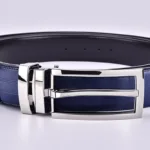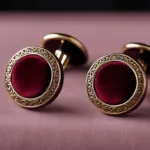Perfecting your formal attire begins with ironing tips for shawl lapel tuxedos, and you, a connoisseur of suave dressing, understand the value of achieving a crisp tuxedo appearance. It’s not just about looking good; it’s about presenting yourself with an air of meticulous care. This guide will equip you with the shawl lapel tuxedo ironing techniques necessary to transform your outfit from ordinary to exceptional.
Key Takeaways
- Ascertain the proper fabric care to maintain the integrity of your shawl lapel tuxedo.
- Employ a pressing cloth and correct iron temperature for safeguarding your tuxedo during ironing.
- For hard-to-iron areas, consider tools like a tailor’s ham to achieve flawless creases.
- Discover alternative ironing methods to keep your tuxedo looking sharp without direct ironing.
- Always prepare with the right tools: a sturdy ironing board, clips, and a spray bottle enhance the ironing process.
The Importance of Ironing Your Shawl Lapel Tuxedo
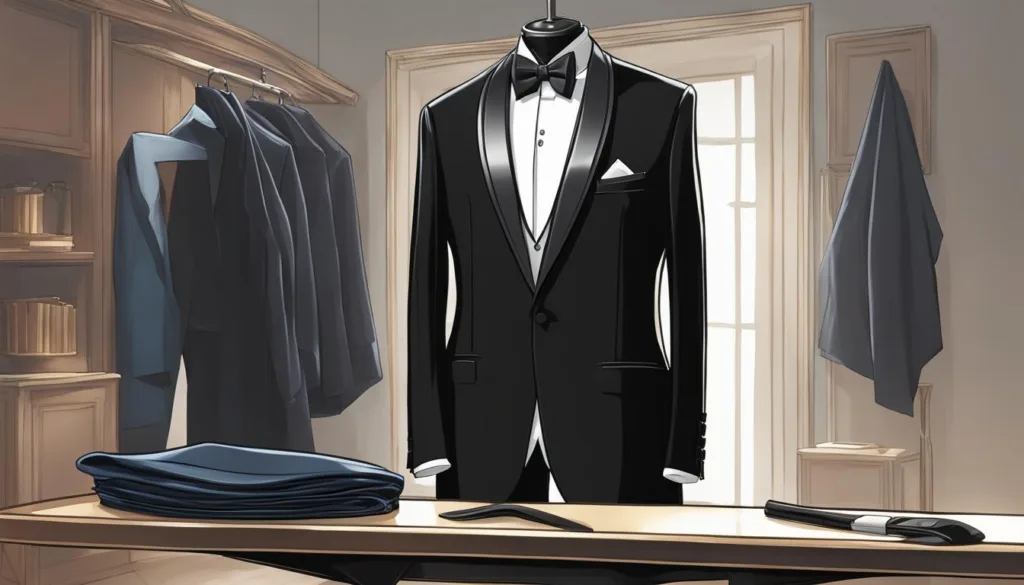
Attaining the perfect silhouette for your shawl lapel tuxedo hinges on recognizing and understanding the unique fabric and structure before you approach the task of ironing. Esteemed for its elegant contour, the shawl lapel requires an ironing regimen tailor-made to its delicate demands to ensure a finish that’s both sleek and immaculate.
Understanding the Fabric and Structure of Your Tuxedo
Your tuxedo’s fabric dictates the ironing approach you should take. Working with materials like wool, silk, or a high-quality synthetic blend requires a delicate touch and precise temperature control to prevent damage and maintain the textiles’ natural sheen. Be mindful, too, of the tuxedo’s built-in architecture; padded shoulders and stitched interfacing should steer the direction of your iron to preserve the original crafting of your attire.
The Role of a Well-Ironed Tuxedo in Formal Wear Presentation
Never underestimate the power of a smoothly ironed tuxedo. It speaks volumes of your style quotient and attention to detail, setting you apart in the sea of formal wear. The shawl lapel, in particular, benefits greatly from proper ironing methods for tuxedos, ensuring that its smooth curve and graceful lines present a pristine profile. From society galas to wedding receptions, the crisp elegance of your tuxedo can leave a perpetual impression of sartorial distinction._MASTERING THESE shawl lapel tuxedo ironing techniques is a sign of a true gentleman-or gentlewoman-who values the essence of meticulous presentation.
- Examine fabric care labels before proceeding with ironing to choose the correct settings for your tuxedo.
- Invest in a high-quality iron with adjustable temperature controls to accommodate various fabric types.
- Utilize a pressing cloth when ironing to provide a protective barrier between the heat source and your tuxedo.
- Incorporate the use of tools such as clamps to maintain the garment’s structure and prevent fabric distortion during ironing.
- Remember, patience and precision in ironing play pivotal roles in maintaining a sleek tuxedo finish.
By adhering to these key principles and incorporating the right techniques, your shawl lapel tuxedo will not only look impeccable but also reflect your sophistication and dedication to the craft of classic elegance.
Step-by-Step Guide to Ironing a Shawl Lapel Tuxedo
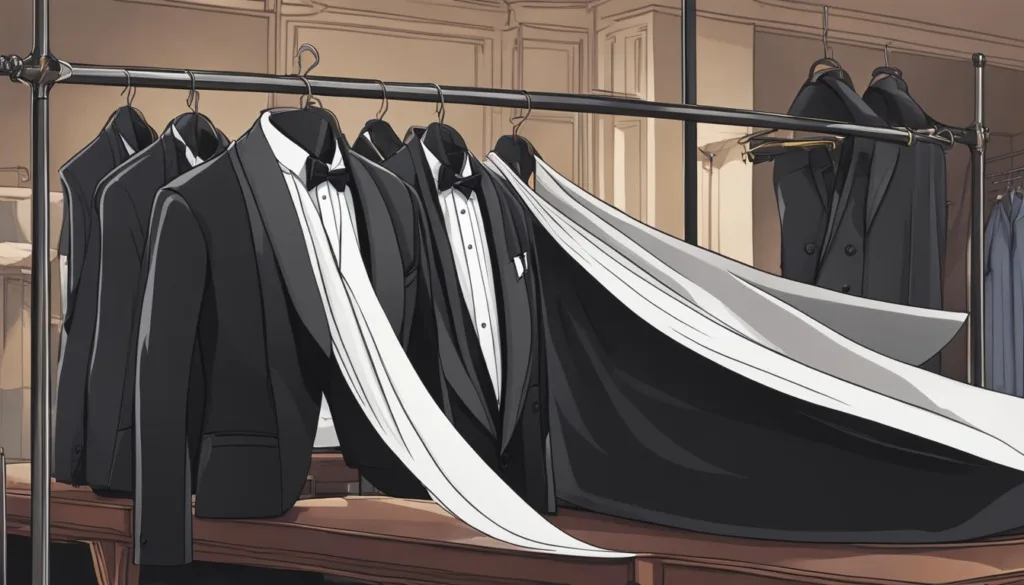
When it comes to sophisticated attire, nothing demands precision quite like a shawl lapel tuxedo. Mastering the shawl lapel tuxedo ironing techniques is less daunting when you have the right approach. Here’s how you can ensure that every fold and crease contributes to an impeccable look for your next high-profile event.
Prepare Your Ironing Station: Begin by setting up an ironing board that’s stable and spacious enough for your tuxedo. Ensure you have all the necessary tools within reach, such as an effective iron with variable settings and a fine-mist spray bottle.
Clothes Hangers and Clips: Start with your tuxedo jacket on a clothes hanger. Apply clips strategically to hold the garment taut, allowing for an even and smooth ironing surface.
Pressing Cloth: Lay a damp pressing cloth over areas of the tuxedo that you will iron, such as the shawl lapel. This essential barrier between the iron and your tuxedo will prevent shine and protect from heat damage.
Iron Settings: Adjust the iron to a heat setting that corresponds with the fabric of your tuxedo. Skipping the steam is a cardinal rule in guidelines for tuxedo ironing to avoid damage to sensitive materials.
The Ironing Process: With the iron preheated to the correct temperature, press gently along the seams, from the inside outwards. This method ensures your tuxedo retains its shape while obliterating any stubborn wrinkles.
| Part of Tuxedo | Ironing Action | Tools to Use | Tips |
|---|---|---|---|
| Shawl Lapel | Press gently, follow the lapel’s curve | Pressing cloth, clamps | Do not press hard; allow the heat to do the work |
| Trouser Seams | Press from the top-down | Tailor’s ham for the waistband | Keep the trousers flat to avoid pleating |
| Entire Tuxedo | Mist lightly and smooth out wrinkles | Spray bottle filled with water | Use minimal moisture to prevent damp spots |
Final Touches: After the entire tuxedo is ironed, turn your trousers inside out and gently go over them once more. This reinforces the creases and presents a polished look that lasts throughout the event.
By following these guidelines for tuxedo ironing, you’re equipping yourself with the skills necessary to maintain the timeless elegance of your shawl lapel tuxedo while optimizing durability. Experience the confidence that comes with a tuxedo that’s as sharp as your event-day readiness.
Techniques for Sharp Shawl Lapel Looks
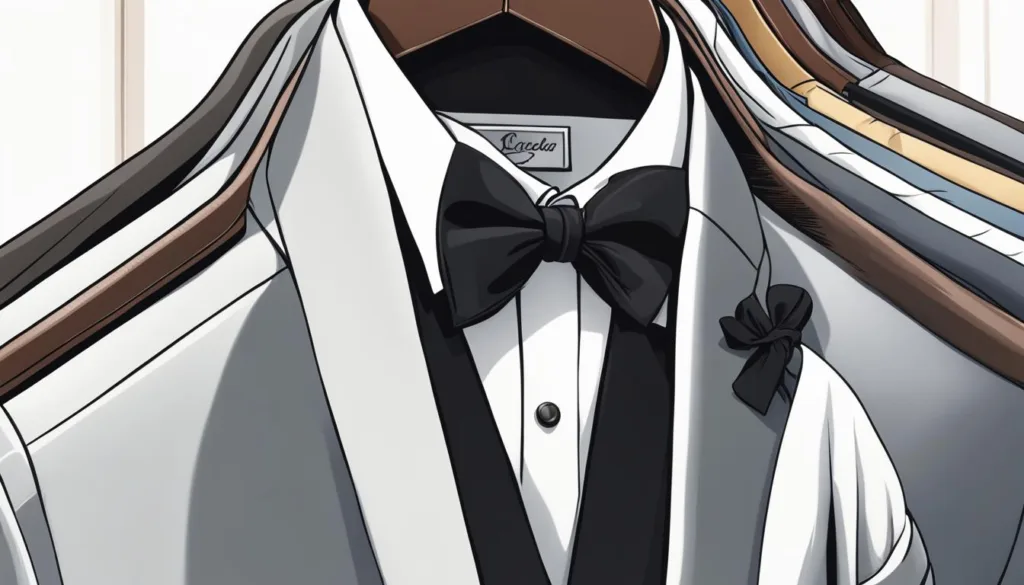
To maintain an aura of sophistication and ensure your shawl lapel suit is the pinnacle of elegance, it is crucial to apply proper ironing methods for tuxedos. This starts with the delicate task of setting your iron to the correct temperature—a critical step in preserving the integrity of the fabric and securing that impeccably smooth finish.
Adjusting the Iron’s Temperature for Different Fabrics
Be mindful that various fabrics composing your tuxedo will react differently when heat is applied. It’s imperative to start with a lower setting to test the iron’s warmth, particularly with sensitive materials like wool, silk, or luxurious synthetic blends found in shawl lapel suits. Adjust the heat incrementally to find the sweet spot where wrinkles smooth out without causing any damage.
Using Pressing Cloths for Added Protection
Augment your ironing technique by employing pressing cloths, an ironing articraft aimed at ensuring smooth shawl lapel suits while offering a shield against any unintended heat marks or sheen. These cloths, preferably fashioned from cotton or silk, not only protect your suit but also facilitate the creation of crisp lines when slightly dampened to produce subtle steam.
Selecting the right pressing cloth and correctly positioning it over your shawl lapel or any other part of your tuxedo can significantly enhance the ironing process. It marks the difference between a suit that’s merely worn and one that carries an inherent sense of grandeur and polish, integral for formal events and special occasions.
- Analyze the fabric of your suit to ensure an accurate temperature setting on your iron.
- Steam from the pressing cloth can be a critical factor in eliminating wrinkles without directly exposing the suit to moisture.
- Consider the weave and texture of the fabric of your tuxedo; fine materials like wool require a delicate touch and a keen eye on the heat gauge.
- When in doubt, lean towards a lower temperature setting to evade the risks associated with high heat.
By heeding these pieces of advice, you can stride confidently into any room, knowing your tuxedo is ironed to perfection—a testament to your dedication to excellence in presentation.
Ensuring Smooth Shawl Lapel Suits
For those pursuing the zenith of elegance, achieving a crisp tuxedo appearance is paramount to making a lasting impression. While the traditional method involves meticulous ironing, alternative techniques for sharp shawl lapel looks can also lead to a refined finish, especially when conventional ironing isn’t feasible.
One such method entails using the natural steam from your shower. Simply hang your shawl lapel suit in the bathroom while you shower; the heat and steam help relax the fabric, reducing wrinkles effortlessly. This technique is particularly useful for maintaining the suit’s pristine condition between more thorough pressings.
Another quick-fix solution involves a tumble in the dryer. Set your dryer to the lowest heat setting, pop your tuxedo in for a brief spin, and let the gentle heat work out any wrinkles, granting your garment a freshened look with minimal effort.
If you’re presented with stubborn folds or creases, investing in a handheld garment steamer can be invaluable. These devices deliver a targeted burst of steam, smoothing out imperfections and rendering a clean, sleek look to your tuxedo.
- Consider the fabric type before choosing your technique; delicate materials may benefit more from the subtler approaches listed above.
- If your suit has encountered significant spills or stains, professional dry cleaning is often the safest choice to restore it to its original glory, following the recommendations on the care label closely.
| Technique | Use Case | Advantages |
|---|---|---|
| Shower Steaming | Mild wrinkles and refreshing fabric | Gentle wrinkle removal; no pressing required |
| Dryer Tumble | Last-minute touch-ups | Convenient and time-efficient |
| Garment Steamer | Stubborn creases and folds | Precision targeting of wrinkles; keeps garments crisp |
While these alternatives to traditional ironing can offer excellent results, nothing can truly replace the crisp, definitive finish provided by a proper ironing session. For impeccable presentation, ensure that you master both the classic techniques and these modern conveniences to keep your shawl lapel tuxedo in peak condition for every grand occasion.
Ironing Best Practices for Formal Wear
When you’re prepping for a formal event, the sharpness of your attire can speak volumes. Ironing best practices for formal wear are imperative to ensure that crisp, authoritative look. Let’s delve into the essential steps for achieving impeccable results with your iron.
Understanding Your Fabrics is the cornerstone of ironing formal wear. Silks, wools, and synthetics each have their own needs when it comes to heat settings. Attention to Detail is key—adjust your iron accordingly, being mindful not to scorch delicate fabrics.
For casual pants like chinos or cotton trousers, a Non-Steam Iron is your best ally. Begin on a lower heat setting and increase as needed, ensuring the fabric is flat and smooth before pressing. Conversely, when tackling dressier trousers, a Steam Iron will help create sharp lines and a polished sheen.
Remember, the goal is to elevate your ensemble, not just to remove wrinkles. A proper ironing technique, paired with attention to the tools at hand, results in professionally pressed pants that compliment your overall formal appearance.
| Fabric Type | Iron Setting | Iron Type | Additional Tips |
|---|---|---|---|
| Casual Cotton Pants | Medium | Non-Steam | Press without steam to avoid over dampening. |
| Formal Trousers | Varies by Fabric | Steam | Steam helps eliminate deep-set creases and provides a crisp look. |
| Delicates (Silk, Satin) | Low | Non-Steam | Always place a pressing cloth between the iron and fabric. |
| Wool | Wool Setting or Medium | Steam | Lightly steam to shape the fabric without crushing the fibers. |
A pressing cloth is a savior for sensitive materials. By placing a layer between your iron and the garment, you circumvent shiny marks or potential burns. For difficult areas such as pleats or the waistband, use a tailor’s ham to support the fabric, ensuring an even press.
And finally, care for your iron. Ensure it’s clean and free of mineral build-up, which can stain fabrics. A well-maintained iron is a potent tool in your arsenal for formal wear preparation.
- Inspect all care labels before adjusting your iron settings.
- Be patient, and give your iron time to warm up to the required temperature.
- Use smooth, consistent strokes for an even press.
- Never leave the iron stationary on the garment to prevent scorching.
Ironing best practices for formal wear are an essential skill set to refine your style and guarantee you look the part for any significant occasion. With these steps, your pressed pants will not only look impeccable but also complement your polished presence.
Mastering the Art of the Perfect Crease
When you’re tasked with preparing a shawl lapel tuxedo, creating a distinctively sharp crease translates to donning an ensemble that epitomizes sophistication. The crease along the lapels, trousers, and sleeves plays a pivotal role in defining the garment’s silhouette, making the process of ironing not just necessary but a form of art itself. As you step into this arena of precision, familiarize yourself with techniques that elevate the quality of your attire.
Traditionally, the pursuit for that razor-sharp edge has been an art form embraced by sartorial experts. Today, this knowledge is accessible to you, offering the ability to bring an elevated level of class to your formal wear through meticulous ironing practices.
The Significance of Pressing Seams and Collars
Pressing seams and collars is where your garment begins to take form, moving from a piece of fabric to a sharply defined structure. The crispness of these folds marks the difference between a suit that is simply worn and one that boasts an authority of its own. With your iron set to the appropriate temperature, approach the collar with a steady hand and an eye for even pressure, ensuring a smooth and unwavering line.
For the seams, concentrate on aligning them perfectly before pressing. This attention to seam work isn’t a mere step but an essential procedure in solidifying the sophistication of your tuxedo. It’s where mastering the art of the perfect crease starts, setting the stage for the rest of the garment to follow.
Utilizing Tailor’s Ham for Precision Ironing
Navigating the nuances of a tuxedo requires tools designed for the task. A tailor’s ham is one such instrument, pivotal in utilizing tailor’s ham for precision ironing. This rounded cushion enables you to press contours seamlessly, contouring to the gentle curves of lapels and intricate folds that a flat surface cannot accommodate.
- Start by heating your iron to the fabric-appropriate setting to prevent any unintended damage. Lower temperatures are typically better for delicate fabrics.
- Place the tailor’s ham beneath the fabric, following the natural line of the shawl lapel or the curves around the collar and armholes.
- Apply gentle, even pressure with the iron, allowing the heat and the shape of the tailor’s ham to mold the fabric without creating new, unwanted creases.
- Rotate the ham as needed to iron all dimensions of the sewn contours, ensuring each section of the seam is perfectly pressed.
This employment of a tailor’s ham is quintessential for those serious about their formal attire, ensuring each arc and angle is respected and realized. By integrating these tailored practices into your ironing routine, you uphold a tradition of excellence and ensuring smooth shawl lapel suits is within your reach.
Mastering the art of the perfect crease is not only about your ability to iron but the pride you take in your appearance. Let your tuxedo be a testament to the diligence and care invested in its preparation, and step forward with the confidence that comes with perfection.
Conclusion
In this guide, we’ve explored the pivotal role that shawl lapel tuxedo ironing techniques play in curating a sharply tailored look, detailing how the polish of your formal attire is much more than superficial. It’s essential to recognize that ironing best practices for formal wear set the tone for your overall presentation and can distinguish you at any upscale event. It’s all in the details—fine fabrics, precise temperature settings, and specialty tools; these are the nuances that make all the difference. The commitment to these methods does more than press fabric; it presses the impression you leave.
As we’ve discussed, there’s an art to ensuring smooth shawl lapel suits, an investment in time and technique that culminates in an exceptional garment ready for the spotlight. Beyond the mechanics of ironing, the elegance of your ensemble speaks to the dedication behind its care. Whether deftly wielding a hot iron over a tailor’s ham or utilizing alternative methods in a pinch, like steam from a hot shower or a few minutes in the dryer, you build skill and versatility ensuring your tuxedo remains impeccably sharp.
Your mastery of these practices transforms an ordinary suit into a statement of exquisite taste. Commit to the art of a well-pressed shawl lapel, and let your attention to every crisp line and smooth surface showcase your sartorial savvy. In the end, you’re not just preparing attire; you’re crafting an image, an experience, a moment to remember. Put your best foot forward, tuxedo impeccably ironed, and ready to make your mark.









